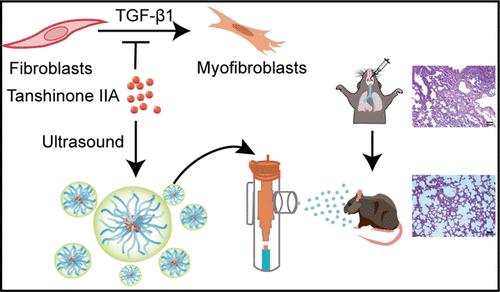丹参酮 IIA 负载吸入式聚合物纳米粒子可缓解已形成的肺纤维化
IF 5.4
2区 医学
Q2 MATERIALS SCIENCE, BIOMATERIALS
引用次数: 0
摘要
特发性肺纤维化(IPF)是一种致命的呼吸系统疾病,其特点是肺实质慢性、进行性瘢痕形成,导致肺功能不可逆转地下降。除了支持性治疗外,目前还没有逆转这种疾病的特效疗法。基于丹参酮 IIA(TAN)通过抑制 Smad 和非 Smad 信号通路避免肌成纤维细胞活化,对 TGF-β1 诱导的纤维化具有保护作用、本研究开发了可吸入的壳聚糖-寡糖包覆聚乳酸-聚乙二醇酸(PLGA)纳米颗粒(CPN@TAN),用于增强丹参酮 IIA 的肺部给药,治疗肺纤维化。粒径为206.5 nm的CPN@TAN表现出优异的体外气溶胶递送特性,其质量中值空气动力学直径(MMAD)为3.967 ± 0.025 μm,细颗粒分数(FPF)为70.516 ± 0.929%。此外,纳米颗粒在雾化过程中表现出良好的稳定性,并增强了粘膜渗透能力。共聚焦光谱结果证实了纳米颗粒作为载体的潜力,可促进 NIH3T3、A549 和 MH-S 细胞对药物的吸收。此外,纳米颗粒还表现出良好的体外生物相容性。在博莱霉素诱导的肺纤维化小鼠模型中,与静脉给药相比,无创吸入气溶胶 CPN@TAN 大大抑制了胶原蛋白的形成,促进了被破坏的肺泡上皮的再上皮化,而不会引起全身毒性。因此,我们基于聚合物的非侵入性吸入给药技术可能是一种前景广阔的范例,为克服与肺纤维化相关的治疗难题打开了大门。本文章由计算机程序翻译,如有差异,请以英文原文为准。

Tanshinone IIA Loaded Inhaled Polymer Nanoparticles Alleviate Established Pulmonary Fibrosis
Idiopathic pulmonary fibrosis (IPF) is a fatal respiratory disease characterized by chronic, progressive scarring of the lung parenchyma, leading to an irreversible decline in lung function. Apart from supportive care, there is currently no specific treatment available to reverse the disease. Based on the fact that tanshinone IIA (TAN) had an effect on protecting against TGF-β1-induced fibrosis through the inhibition of Smad and non-Smad signal pathways to avoid myofibroblasts activation, this study reported the development of the inhalable tanshinone IIA-loaded chitosan-oligosaccharides-coated poly(lactic-co-glycolic acid) (PLGA) nanoparticles (CPN@TAN) for enhancing the pulmonary delivery of tanshinone IIA to treat pulmonary fibrosis. The CPN@TAN with a size of 206.5 nm exhibited excellent in vitro aerosol delivery characteristics, featuring a mass median aerodynamic diameter (MMAD) of 3.967 ± 0.025 μm and a fine particle fraction (FPF) of 70.516 ± 0.929%. Moreover, the nanoparticles showed good stability during atomization and enhanced the mucosal penetration capabilities. The results of confocal spectroscopy confirmed the potential of the nanoparticles as carriers that facilitated the uptake of drugs by NIH3T3, A549, and MH-S cells. Additionally, the nanoparticles demonstrated good in vitro biocompatibility. In a mouse model of bleomycin-induced pulmonary fibrosis, noninvasive inhalation of aerosol CPN@TAN greatly suppressed collagen formation and facilitated re-epithelialization of the destroyed alveolar epithelium without causing systemic toxicity compared with intravenous administration. Consequently, our noninvasive inhalation drug delivery technology based on polymers may represent a promising paradigm and open the door to overcoming the difficulties associated with managing pulmonary fibrosis.
求助全文
通过发布文献求助,成功后即可免费获取论文全文。
去求助
来源期刊

ACS Biomaterials Science & Engineering
Materials Science-Biomaterials
CiteScore
10.30
自引率
3.40%
发文量
413
期刊介绍:
ACS Biomaterials Science & Engineering is the leading journal in the field of biomaterials, serving as an international forum for publishing cutting-edge research and innovative ideas on a broad range of topics:
Applications and Health – implantable tissues and devices, prosthesis, health risks, toxicology
Bio-interactions and Bio-compatibility – material-biology interactions, chemical/morphological/structural communication, mechanobiology, signaling and biological responses, immuno-engineering, calcification, coatings, corrosion and degradation of biomaterials and devices, biophysical regulation of cell functions
Characterization, Synthesis, and Modification – new biomaterials, bioinspired and biomimetic approaches to biomaterials, exploiting structural hierarchy and architectural control, combinatorial strategies for biomaterials discovery, genetic biomaterials design, synthetic biology, new composite systems, bionics, polymer synthesis
Controlled Release and Delivery Systems – biomaterial-based drug and gene delivery, bio-responsive delivery of regulatory molecules, pharmaceutical engineering
Healthcare Advances – clinical translation, regulatory issues, patient safety, emerging trends
Imaging and Diagnostics – imaging agents and probes, theranostics, biosensors, monitoring
Manufacturing and Technology – 3D printing, inks, organ-on-a-chip, bioreactor/perfusion systems, microdevices, BioMEMS, optics and electronics interfaces with biomaterials, systems integration
Modeling and Informatics Tools – scaling methods to guide biomaterial design, predictive algorithms for structure-function, biomechanics, integrating bioinformatics with biomaterials discovery, metabolomics in the context of biomaterials
Tissue Engineering and Regenerative Medicine – basic and applied studies, cell therapies, scaffolds, vascularization, bioartificial organs, transplantation and functionality, cellular agriculture
 求助内容:
求助内容: 应助结果提醒方式:
应助结果提醒方式:


